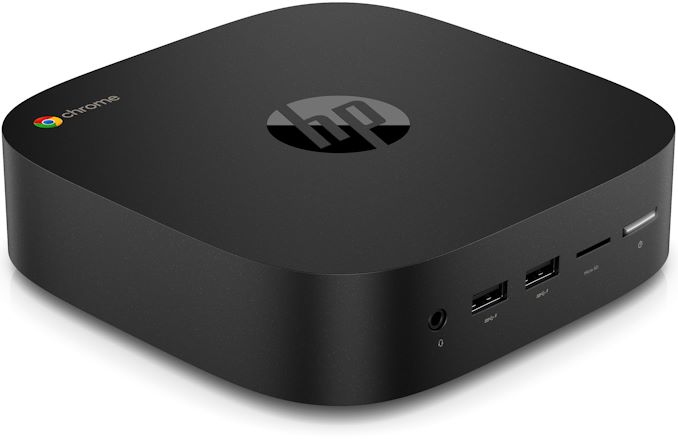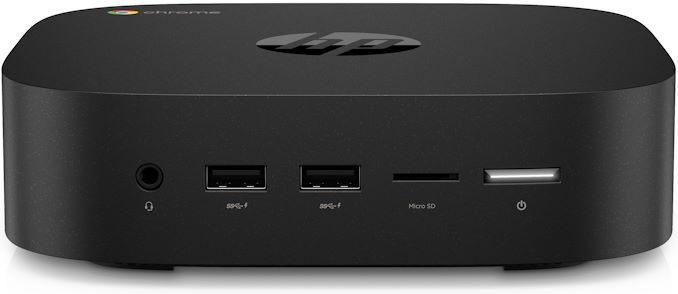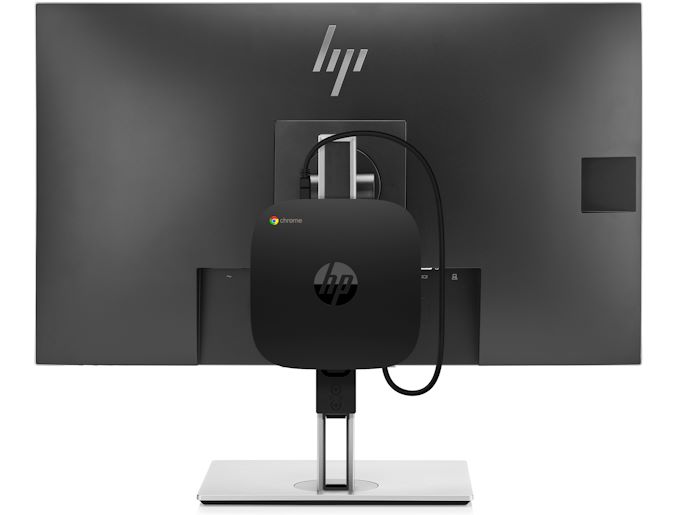HP Unveils Chromebox Enterprise G2: A Chrome OS-Based Business Desktop
by Anton Shilov on October 14, 2019 5:00 PM EST- Posted in
- Desktop
- HP
- Chrome OS
- Chromebook
- UCFF
- Chromebox for Enterprise

Business and enterprise desktops is an interesting market recently - on the one hand, because extended support for Windows 7 nears its end early in 2020, multiple companies are eager to buy new PCs; on the other hand, margins are low and competition between suppliers is cut-throat. To minimize competition, HP has released one of the industry’s first Chromebox for Enterprise: a UCFF desktop PC for frontline workers, call centers, shared spaces, kiosks, or digital signage applications.
The Chromebox Enterprise G2 comes in a small 14.93×14.93×4 cm black box that packs Intel’s 7th Generation dual-core Core i3-7130U with UHD 620 graphics CPU or Celeron 3867U with UHD 610 graphics CPU that is paired with 16 GB DDR4-2400 DRAM as well as an M.2 SSD.
In a bid to meet requirements of all possible applications, the Chromebox Enterprise G2 features rather vast connectivity capabilities that include GbE, Wi-Fi 5, Bluetooth 4.2, three USB 3.0 Type-A ports, two USB 2.0 Type-A ports, one USB Type-C connector, one HDMI display output, one 3-in-1 SD card reader, and a 3.5-mm headphone jack. Depending on configuration, the Chromebox Enterprise G2 comes with a 65 W or a 90 W power brick.
| HP's Chromebox Enterprise G2 | |||
| Model | Celeron | Core i3 | |
| CPU | Intel Celeron 3867U (2C, 1.8 GHz, 2 MB cache) |
Intel® Core i3-7130U (2C, 2.7 GHz, 3 MB cache) |
|
| GPU | Intel HD Graphics 610 | Intel HD Graphics 620 | |
| DRAM | 16 GB DDR4-2400 Two DDR4 SO-DIMM slots |
||
| Motherboard | proprietary | ||
| Storage | SSD | 32 GB or 64 GB M.2 SSD | |
| DFF | - | ||
| SD | 3-in-1 card reader | ||
| Wireless | Intel Dual Band Wireless-AC 7265 802.11ac (2x2) and Bluetooth 4.2 | ||
| Ethernet | 1 × GbE port (Realtek RTL8151GH-CG GbE LOM) | ||
| USB | Front | 1 × USB 3.0 Type-A | |
| Back | 1 × USB 3.0 Type-C 1 × USB 3.0 Type-A 2 × USB 2.0 Type-A |
||
| Display Outputs | 1 × HDMI | ||
| Audio | 1 × 3.5mm audio jack for headsets (Realtek ALC5662-CG codec) | ||
| PSU | External 65 W | External 90 W | |
| Warranty | Typical, varies by country | ||
| Dimensions | Length: 14.93 cm | 5.87 inches Width: 14.93 cm | 5.87 inches Height: 4 cm | 1.57 inches |
||
| OS | Chrome OS with Chrome Enterprise Upgrade | ||
| MSRP | ? | ? | |
Unlike Chromebooks, Chromeboxes have not really gained traction on the market partly because people expect high performance and advanced multimedia capabilities from their desktops, but mostly because people are so used to Windows programs. By releasing a Chromebox for Enterprise, HP obviously faces some risks, but believes that since many people use web-based apps nowadays, they will use a Chrome OS-based desktop without any problems. Meanwhile, the advantage of web-based applications is also their disadvantage because they depend on reliability of Internet connection. On the other hand, one indisputable trump that HP’s Chromebox Enterprise G2 has is support for numerous capabilities aimed precisely at businesses, including 24/7 Google support, automatic software updates through June 2024, virus protection, sandboxing, verified boot, remote management, and easy deployment. All in all, it will be interesting to sell how successful HP’s Chromebox for Enterprise is going to be.
HP’s Chromebox Enterprise machines will be available in November. Pricing will depend on configurations.
Related Reading
- HP Unveils Chromebooks for Enterprise: AMD and Intel
- HP at CES 2019: HP Chromebook 14 Combines AMD and Chrome OS
- HP Unveils Premium Chromebook: 3K Display, Intel Core M, 16 GB of RAM and USB-C
- Acer’s Chromebox CXI3 Available in Four Configs: Up to Core i7-8550U, Up to $777
- Acer Announces New Chromebooks And Chromebox Devices
Source: HP













39 Comments
View All Comments
webdoctors - Tuesday, October 15, 2019 - link
You obviously haven't tried Google Sheets.LibreOffice is very capable.
Anyways, most companies just have laptops for everyone.
Cliff34 - Tuesday, October 15, 2019 - link
If not for excel, how is Libre office word and PowerPoint compare to Office? I never tried Libre office but I can bet that there's no way you can make great looking word doc or ppt slides on it.The question is why they can't they put Windows os on it? Of course you pay more for licensing but it is possible.
Death666Angel - Tuesday, October 15, 2019 - link
I'd take that bet. The tools in both versions of Office are pretty much the same it is just people unfamiliar with how things are done in LO that get sub par results. If you go into both with the same knowledge level, the results will be pretty much identical. Also, there is no such thing as a great looking PP presentation. Just saying.Retycint - Tuesday, October 15, 2019 - link
The issue is that most people in a corporate environment is trained/familiar with Office only, so switching incur high re-training costs and impedes day-today functioning (at least during training). Is this LO's fault? No, but that just the realityIronchef3500 - Tuesday, October 15, 2019 - link
hehezepi - Tuesday, October 15, 2019 - link
Office365 is available for chromebooks.Ironchef3500 - Tuesday, October 15, 2019 - link
+1SanX - Monday, October 14, 2019 - link
Why not use cellphone chips like Snapdragon, Kirin or Helio ? Use dual-chip if not enough power. The box will be still 3 times cheaperstephenbrooks - Monday, October 14, 2019 - link
Maybe the ultimate evolution of this is docking your company phone to a screen?Retycint - Tuesday, October 15, 2019 - link
Pentium is cheap enough and they can just recycle the mobo from any laptop/box PCs they had in the past. Whereas using an ARM chip probable requires designing of a new mobo, or at least one that costs more to design/manufacture, thus negating the cost savings of an ARM chip